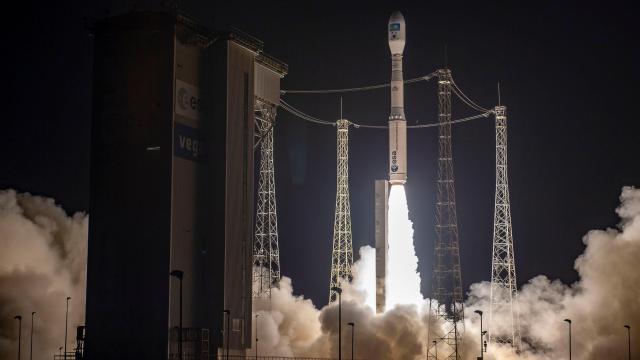The European Space Agency (ESA) announced the results of a months long investigation into the failed launch of its Vega-C rocket back in December, pinpointing a malfunction with a motor component as the reason behind the catastrophic anomaly.
The Independent Enquiry Commission shared the results of its investigation on Friday, revealing that the reason behind the mission failure was a gradual deterioration of the Vega-C second stage’s nozzle, ESA wrote in a statement.
Vega-C took off on December 20, 2022 from the Kourou Space Centre in French Guiana, carrying the Neo 5 and Neo 6 satellites for for Airbus’ Pléiades Neo Earth-imaging constellation. About two minutes and 27 seconds after launch, the rocket’s second stage, called the Zefiro 40, suffered a decrease in pressure and the mission was terminated. The rocket, developed by ESA, built by Italian company Avio, and operated by Arianespace, failed to reach orbit and its payload was destroyed.
According to the results of the investigation, the throat insert of Zefiro 40’s nozzle — the part of the motor where the hot exhaust leaves the combustion chamber — suffered from a “thermo-mechanical over-erosion,” ESA wrote. When the throat insert eroded, the chamber pressure dropped and caused a decrease in the rocket’s thrust. The commission concluded that the material that makes up the throat insert, a specific type of carbon-carbon (C-C), would no longer be used for flight, and that the breakdown was “likely due to a flaw in the homogeneity of the material,” ESA wrote. Avio procured this faulty part from Ukraine.
“Considering the nature of the VV22 anomaly, the Commission emphasises that its conclusions on Zefiro 40 do not affect the Vega launcher,” ESA wrote in its statement. “In this context, Arianespace decided to adapt its launch schedule to reassign a mission to one of its two remaining Vega launchers with a targeted launch date before the end of summer 2023.”
Vega-C made its debut in July 2022, taking off for the first time from the space agency’s launch facility in Guiana. The medium-lift rocket was hailed as a worthy successor to the small Vega launcher, which was in operation for ten years. The European space industry as a whole was counting on Vega-C to provide a kind of local access to Earth orbit, delivering payloads and maintaining Europe’s presence in the industry.
The rocket’s second go at liftoff may not have gone as planned, but ESA and Arianespace is ready to see Vega-C fly again.
More: Astra Investigation Uncovers Cause of Failed Rocket Launch.
